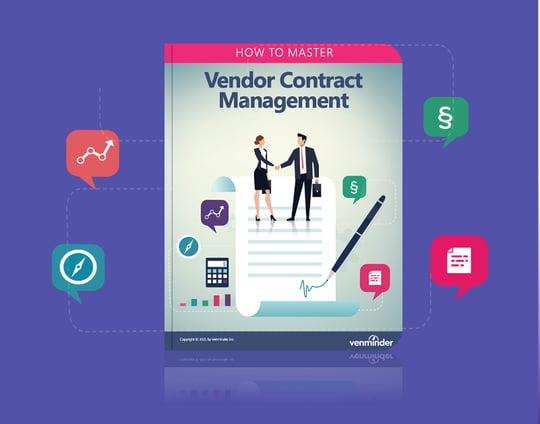Well-written vendor contracts are at the core of strong third-party vendor relationships. A vendor contract is a legally binding document used to outline specific duties by each party for a duration of time. Therefore, there are some risks that arise if the contract is poorly written or implemented. While there are several potential risks, we'll review 3 risks we believe pose a particular concern with vendor contracts.
3 Risks of Poorly Written or Implemented Vendor Contracts
Non-compliance:
Regulatory compliance is often a driving force behind many third-party risk management (TPRM) processes, especially contract management. Managing your vendor contracts is an important step to avoid enforcement actions, like hefty fines from your regulator.
Here are a few ways in which contract management can put you at risk for regulatory actions:
-
- Undocumented vendor vetting and risk assessment: Regulators want to see that your organization has taken the proper steps to assess multiple third-party vendors BEFORE making a vendor selection and signing the contract. This is a crucial step of the TPRM lifecycle that gives more insight into the possible risks that could arise if the selected vendor failed to perform as expected. By jumping into a contract without documenting the vendor’s risk and comparing the risks to the other vendors that were vetted, you’ll be setting yourself up for some potentially serious consequences.
- Inconsistent contract tracking: Don’t make the mistake of thinking that signing the contract is the final step of the process. It’s important to keep your vendor contracts in a centralized repository so that you can easily monitor and review your contracts throughout the lifespan to ensure they consistently meet your expectations and remain compliant. Tracking auto-renewals and expiration dates are also an important step to avoid renewing a contract that you might otherwise have wanted to terminate after its expiration.
- Inadequate information security and confidentiality provisions: Protecting sensitive information from data breaches and other cybersecurity incidents is not only an important practice for your organization, but also for your vendors. The contract should clearly define your vendor’s responsibility to adhere to policies and procedures that safeguard against events like accidental exposure or unauthorized access of non-public personal information (NPPI).
Financial Liabilities:
When signing a vendor contract, it’s expected that both parties will want to ensure that the financial terms are well-defined and fair. However, improper contract management can put you at risk for financial liabilities like costly rework or early termination fees.
Consider the following elements that can affect your bottom line:
- Unclear termination rights: If your termination rights aren’t clearly defined in your vendor contract, it’s unlikely that your organization will be able to break the contract because of issues like vendor performance, breaches or other non-compliance issues. Thorough and concise termination language in your vendor contracts will help ensure your organization can end the contract without facing early termination fees or litigation.
- Undefined service level agreements: Service level agreements (SLAs) are a crucial component of a critical vendor contract. The SLAs allow your organization to clarify the expected standards for the delivery of the products and services, while also establishing consequences (penalties) for non-performance. For example, if penalties, including exit language for non-performance, are not included in the contract, you might be forced to remain with that vendor while also bringing on a new vendor who can actually provide the product or service as expected. This is just one example of potential increased costs due to inadequate contract management, as you could be paying two vendors for the same product or service.
- Missed renewals: It’s easy to lose track of expiring contracts and their required notification dates. Having a solid contract management process should help avoid these unwanted renewals which also include unwanted expenses.
Operational Risks:
Regulatory actions and financial risks are certainly important to consider in vendor contract management, but operational risks can also have a negative impact on your business activities.
Having unclear terms in your contracts can lead to inefficient processes and wasted time through the following ways:
-
- Misidentified roles and responsibilities: Without clearly identifying the roles within your TPRM program and within your vendor relationships, you’ll probably run into time consuming issues down the line. Individuals should be aware of their roles and responsibilities so any emerging problems can be quickly addressed.
- Decentralized and manual process: Contract management can be one of the most time-consuming portions of TPRM. It’s important to have automated processes in place that are centralized and continuously reviewed addressing all of the stages of contract management (i.e., vetting, drafting, negotiating, approving and executing). When this is done in a decentralized or manual manner, processes are generally duplicated or not followed. A decentralized process also means too little control over contractual terms.
- Poor contract visibility: The lack of appropriate visibility of all vendor contracts can lead to several issues such as lost revenue or added costs. It can also be a potential reputation risk concern – if you aren’t aware of a contract, you probably aren’t aware of the vendor and its reputation.
- Ineffective reporting: Reporting to senior management and the board is a regulatory requirement for many industries. Having an inadequate contract management process lends itself to inadequate reporting where vendor vulnerabilities might go unnoticed until becoming a bigger, more costly issue.
As you can see, creating and managing a vendor contract is a crucial practice within third-party risk management, which can affect an organization in many ways. Make sure to include your legal team and other applicable departments when reviewing your vendor contract to help protect your organization from some of these risks.

















